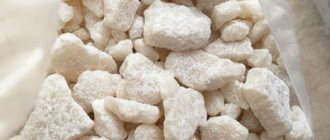Barbiturates
It is very important to know how to remove barbiturates from the body during intoxication in order to avoid serious complications. Unfortunately, no person is immune from poisoning or intoxication. Barbiturate poisoning is a very common phenomenon nowadays. These substances are included in many pharmacological drugs. Also at risk are children and the elderly, whose bodies are even more prone to poisoning by these substances. It is for this reason that it is important to know how barbiturates are eliminated from the body.
Drugs
Taking medications without permission can be harmful. Everyone knows about this, but they continue to use drugs “on the advice” of friends, relatives or pharmacists, often without the slightest idea about the composition, side effects or correct use. As a result, during a urine drug test, an unexpected positive result is obtained.
List of drugs containing barbiturates:
- Andipal.
- Valocordin.
- Valoserdin.
- Corvalol.
- Corvaldin.
- Sedalgin.
- Valoferin.
- Lavocordin.
- Pentalgin (and its modifications).
- Neo-Theophedrine.
- Tetralgin.
- Theophedrine.
- Angisedin.
- Pulsnorma.
- Spasmoveralgin.
- Sedalgin.
- Tepaphylline.
- Neoclimastilbene.
- Thiopental.
- Butizol.
- Veronal.
- Amytal.
- Sedonal.
- Sedal.
- Piralgin and others.
The list of drugs can be continued indefinitely, because it contains more than 2,500 items. In some cases, a positive test for barbiturates in the urine can result from taking anticonvulsants that are imidazolidine derivatives (Hydantoin). For example: Etotoin, Phenytoin, Dilantin and others. These drugs are close in chemical composition to barbiturates (Phenobarbital), but are not them.
History of origin
Barbiturates were synthesized in Munich in 1864. Chemists working for Adolf von Baeyer, the founder of the famous pharmaceutical company, mixed malonic acid and urea. The resulting compound temporarily euthanized laboratory mice and stopped their seizures, so work on a drug with interesting characteristics continued.
The substance got its name from a combination of the words “Barbara” (the saint on whose day the compound was discovered) and “urate” (urea). Soon derivatives of barbiturates appeared on the market: barbital, phenobarbital were used as sleeping pills; sodium thiopental - for euthanasia of animals and executions; sodium amytal was included in the “truth serum”. Back then, no one imagined that those who were prescribed a new drug would soon become drug treatment patients.
Gradually, the scope of use of barbiturates expanded. Today they are part of such well-known drugs as Nurofen, Corvalol, Pentalgin and other drugs sold at an affordable price and without a prescription in Krasnodar and other cities. One-time use of the substance is not addictive, but regular use of even harmless valerian and motherwort can lead to severe addiction.
Withdrawal time
The patient must submit a urine drug test. He is sure that no means, including medications, were used. However, the test shows a positive result. Where does Phenobarbital come from in urine?
Everything is very simple. Some time before the tests, I took medications containing barbiturates. The most common culprits of a positive analysis are: Andipal, Corvalol, Valocordin, Valoserdin, Sedalgin, Pentalgin.
According to various sources, the period of elimination of barbiturates ranges from 7 days to 45 days. That is, the test analysis can be positive for up to a month after taking medications.
The rate of excretion is influenced by various factors:
- Functioning of the urinary system. Barbiturates are excreted primarily through the kidneys, more precisely in the urine. If there are disturbances in the functioning of the kidneys (urolithiasis, nephritis, pyelonephritis, etc.), the rate of elimination of traces of the drug slows down significantly.
- General condition of the body: metabolic processes, level of immunity. The stronger the patient’s health, the sooner the drug taken will leave the body. Accordingly, poor health prolongs the likelihood of detecting traces of illegal drugs taken.
- Duration of use and dosage of the drug. Long-term use of the same Corvalol, especially in high dosage, when conducting a urine test for barbiturates, will show a positive result. Accordingly, to avoid this, you must wait at least 7-14 days before the test.
Acceptable rate
- Phenobarbital - 1000 ng/ml.
- Barbamil -100 ng/ml.
- Sodium etaminal -100 ng/ml.
From the data provided, we can conclude that if there is a positive urine test result, but with data that is below the threshold value, it is impossible to talk about drug use.
A more detailed analysis will reveal the components of the medications taken. However, a more reliable argument will be the prescription form of the prescribed drug.
What are they threatening?
What are the risks for a person when detecting Phenobarbital and other barbiturates in urine? It all depends on the circumstances of the discovery of the drug.
If a test analysis was carried out on a driver who committed a hit-and-run or a road traffic accident (RTA), and the result was positive, then the minimum punishment is deprivation of a driver’s license. If there are injured or dead, then a positive test is an aggravating circumstance. The driver becomes guilty of driving while intoxicated.
Barbiturate-based drugs taken in small doses will never exceed the threshold values in a urine test. Therefore, if during a test analysis the sample gives a positive result, then it is necessary to request a repeat test in order to detect the amount of the prohibited substance. In this case, a chemical-toxicological or forensic chemical study is carried out, based on the results of which a decision will be made.
Taking medications without a doctor's prescription and in a chaotic manner leads to undesirable consequences and complications. And sometimes even to litigation.
Even after a single use, drugs remain in the blood and urine for a long time.
- Content
When laboratory tests are performed, traces of chemical metabolites are detected within 2–7 days.
How to remove barbiturates from the body, what detoxification methods can be used at home?
Complications after treatment
Pulmonary edema
The body responds to toxins unpredictably, even if the therapy was timely and effective. Complications that arise over time will not only be unpleasant, but also very dangerous:
- varying degrees of pulmonary edema;
- degradation of the skin;
- nervous system disorders;
- sudden swelling of the brain.
Important! After therapy, it is necessary to monitor your health, eat healthy foods, avoid hypothermia and avoid taking medications based on barbituric acid.
Symptoms of barbiturate poisoning
Signs of drug intoxication manifest themselves in different ways. The clinical picture depends on which drug the person took.
Poisoning with short-acting barbiturates causes difficulty breathing, the condition quickly normalizes with timely ventilation.
Symptoms of barbiturate poisoning include breathing problems, heart problems and loss of consciousness
There are 4 stages of chemical intoxication:
- falling asleep;
- superficial coma;
- deep coma;
- post-comatose state.
First, the person becomes drowsy, lethargic, and his reaction to external stimuli worsens.
Later, the patient loses consciousness, respiratory depression, tachycardia, weakening of the swallowing and cough reflex are observed, blood pressure drops, and body temperature rises to 40˚.
In deep coma, motor reflexes are completely absent, and the functioning of vital systems and organs is disrupted.
Cardiovascular and renal failure develops. An overdose of barbiturates can cause collapse and death.
In a post-comatose state, the functioning of the body is gradually restored, and the person regains consciousness.
During the first 24 hours, an unstable psycho-emotional state (irritability or tearfulness) and insomnia persist. Often trophic disorders and mental disorders persist for life.
Time frame for removing barbiturates from the body
On average, illicit drugs are eliminated from the body within 79 hours. Metabolism occurs in the liver, and breakdown products are excreted by the kidneys.
The blood is cleansed after 1–2 days; toxic elements remain in the hair and nail plates for up to 3 months.
The time it takes for barbiturates to leave the body depends on the duration of use and health status.
How long does barbiturate last in the urine after a single dose? In urine, traces of the chemical remain the longest and can be detected 2-4 days after a single use. When taking drugs systemically, toxic metabolites are detected in the urine within 1–3 weeks.
Mechanism of action
Barbiturates differ in their action from many tranquilizers and hypnotics. The features of these drugs include:
- The effect on the nervous system depends solely on the dose of the drug. In small dosages, barbiturates provide a mild sedative effect. In slightly larger doses they act as a sleeping pill, and in larger doses as a narcotic.
- With prolonged use there is a possibility of addiction. Dependence can be both physical and mental.
- Symptoms of overdose can occur even if the therapeutic dose is slightly exceeded.
- The removal of barbiturates from the body is very slow. Consequences can be observed even after a single dose of tablets or drops. If you take the medicine in the evening, in the morning you often experience weakness, pain in the back of the head and atypical drowsiness.
- Barbiturates affect sleep. Thanks to these drugs, the so-called REM sleep phase becomes very short. Which ultimately leads to nervous disorders.
Since barbiturate-based drugs stay in the body for a long time, it is very easy to get poisoned. An overdose of these substances poses a great danger to humans, as there is a high probability of death. An overdose can be accidental, if the doctor’s recommendations are not followed, and deliberately for the purpose of suicide.
The human body quickly gets used to drugs containing barbiturates. People who take sedatives and anti-anxiety drugs for a long time may find that they need increasingly larger doses.
How long does Corvalol last in urine?
It is almost impossible to determine exactly how long the components of Corvalol will be present in the patient’s urine. This fact is explained by the fact that the rate of elimination of drug substances from the human body can be influenced by various factors, including the following:
- The performance of the urinary system. Since barbiturates are excreted from the body primarily through the kidneys with urine, the length of time Corvalol remains in the body will depend on the condition of the urinary system. For example, if a patient has nephritis or pyelonephritis, the rate of elimination of the drug components will be significantly reduced.
- General health. Even without deep knowledge of anatomy, anyone can conclude that the speed of metabolic processes and the level of immunity are directly dependent on the duration of the removal of Corvalol compounds from the urine. Naturally, in poor health, the components of the drug remain in the body for a longer time.
- Duration of use and dosage of the product. Long-term use of Corvalol in doses exceeding the permissible values increases the period of content of the drug components in urine. Therefore, if it is necessary to take a test for barbiturates, the patient should stop taking the medication at least 7-14 days before the test.
Incompatibility with drugs
When taking tests, warn doctors about taking Phenobarbital and drugs based on it, since they affect the level of bilirubin in the blood, reducing it. It is necessary to adhere to the rules for taking the drug in combination with other medications, since the harm to the body from using some of them at the same time may exceed the benefits.
- Lethargy and overdose are caused by taking it in combination with valproic acid and MAO inhibitors.
- Reduced hypnotic and sedative effects when combined with caffeine.
- The therapeutic effect is inhibited if combined with folic acid.
- The nervous system is strongly suppressed when used simultaneously with Primidon and Felbamate.
- Efficiency decreases when mixed with Felodipine, Verapamil, Nimodipine.
The popular medicine Corvalol, which is loved by the people and taken for heart ailments, is in fact not a remedy for this. It only depresses the functioning of the nervous system, relieving the effects of emotional stress, giving the appearance of peace.
How long does Corvalol stay in the blood?
The half-life of the drug from plasma in adults is 53-118 hours (average 79 hours). Based on the data presented, we can conclude that the drug will completely leave the body in about 5-8 days.
You can find out how much of the drug is currently in the blood through a special study. No preparation is required for the test. The analysis is aimed at identifying barbiturates in biological material. The minimum content of phenobarbital in the blood when taking Corvalol is considered to be the norm.
Phenobarbital belongs to the group of narcotic drugs, since its long-term use can cause the formation of persistent addiction, comparable even to alcohol dependence. Moreover, it is worth noting the fact that an overdose of a substance leads to the development of intoxication of the body and can cause death.
There is no need to be afraid if the study revealed minimal levels of phenobarbital in the body. The permissible level of the substance in urine is up to 1000 ng/ml, and when Corvalol is used only for medicinal purposes, this indicator will never exceed the threshold values.
First aid
Calling a team of doctors should be the first point in terms of assistance. Then you need to rinse your stomach several times, preferably with cool boiled water, to which you can add a teaspoon of salt per glass of liquid.
Gauber's salt is a laxative, the use of which is the only useful one in the treatment of this type of intoxication. If the drug is not available, you cannot replace it with others, as it can cause harm. It is allowed to give tea and coffee to the victim.
In case of loss of consciousness, you need to make sure that the tongue does not sink in; to do this, you need to turn the patient on his side, fix the position, press the tongue with something, allowing air access. If necessary, chest compressions can save lives.
Video: doctor's reviews of the drug Phenobarbital.











